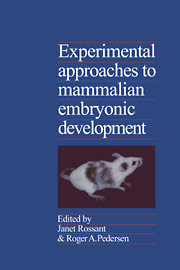Book contents
- Frontmatter
- Contents
- Preface
- Contributors
- Cellular aspects
- 1 Potency, lineage, and allocation in preimplantation mouse embryos
- 2 Time and space in the mouse early embryo: a cell biological approach to cell diversification
- 3 Comparative aspects of embryo manipulation in mammals
- 4 Development of extraembryonic cell lineages in the mouse embryo
- 5 Analysis of tissue fate and prospective potency in the egg cylinder
- Molecular and biochemical aspects
- Toward a genetic understanding of development
- Index
3 - Comparative aspects of embryo manipulation in mammals
from Cellular aspects
Published online by Cambridge University Press: 31 March 2010
- Frontmatter
- Contents
- Preface
- Contributors
- Cellular aspects
- 1 Potency, lineage, and allocation in preimplantation mouse embryos
- 2 Time and space in the mouse early embryo: a cell biological approach to cell diversification
- 3 Comparative aspects of embryo manipulation in mammals
- 4 Development of extraembryonic cell lineages in the mouse embryo
- 5 Analysis of tissue fate and prospective potency in the egg cylinder
- Molecular and biochemical aspects
- Toward a genetic understanding of development
- Index
Summary
Introduction
For many, mammalian embryology is synonymous with mouse embryology. This docile laboratory rodent is so inexpensive and convenient for research in experimental embryology that our concepts of the mechanisms of early mammalian development have largely been shaped by research on this single species. Notwithstanding, a vast literature and long tradition of comparative embryology stretching back to the time of Aristotle attest to the differences and similarities between embryos of different classes and species. Even among mammals there have been many fruitful studies of comparative embryology using a wide range of species. Only recently, however, have experimental techniques been applied to mammalian embryos with the intent of elucidating the underlying mechanisms guiding development. With the growth of this field, the advantages of laboratory rodents, particularly mice, became evident. More and more work was concentrated on this animal, making it a better-defined tool for continued study. For example, genetic studies of mice, which have their roots in the old mouse fancy, led to the present situation in which more is known about the genetic makeup of mice than any other mammal apart from humans. Clearly this is an advantage to the experimental embryologist who can use genetic identity to decrease experimental variation and genetic differences to provide markers to identify the origins of cells. Thus, controlled genetic variation on an otherwise uniform genetic background has become an integral part of experimental embryology, and mice provide the most flexibility for the use of this tool. Similarly, with other aspects of mouse development, the more information there is available, the more inclined researchers are to use this information to approach specific problems.
- Type
- Chapter
- Information
- Publisher: Cambridge University PressPrint publication year: 1987
- 1
- Cited by



